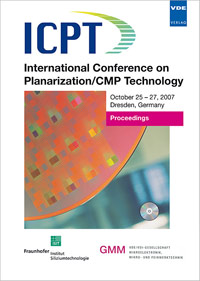Experimental Analysis on CMP Mechanism of Single Crystal SiC
Conference: ICPT 2007 - International Conference on Planarization / CMP Technology
10/25/2007 - 10/27/2007 at Dresden, Germany
Proceedings: ICPT 2007
Pages: 5Language: englishTyp: PDF
Personal VDE Members are entitled to a 10% discount on this title
Authors:
Lee, Houjun; Jeong, Sukhoon; Seo, Heondeok; Park, Beomyoung; Oh, Jiheon; Jeong, Haedo (Dept. of Precision & Mechanical Engineering, Pusan National University, Busan 609-735, Korea)
Kim, Hyoungjae (Busan R&D Center, Korea Institute of Industrial Technology, Busan 609-735, Korea)
Abstract:
Silicon carbide (SiC) is expanding its application field as a next generation compound semiconductor because of its significant advantages in high power, high frequency, low coefficient of thermal expansion and high thermal conductivity. For the manufacturing of SiC to semiconductor substrate, many researchers have studied on the subject of SiC polishing. However, it is difficult to polish without defects such as scratches and subsurface damages, because SiC is a chemically and mechanically stable material. Therefore, hybrid process, chemical mechanical polishing (CMP) has been proposed to achieve epi-ready surface followed by fine diamond polishing. In this paper, the material removal rate (MRR) is investigated to recognize how long the CMP process continues to remove a damaged layer by mechanical polishing using 100 nm sized diamond, and find the dependency of mechanical factors such as pressure, velocity and abrasive concentration using NaOH based colloidal silica slurry. Especially, the authors tried to get an epi-ready surface with mixed abrasive slurry (MAS), in order to increase the removal activity and balance between mechanical and chemical factors in CMP process.


